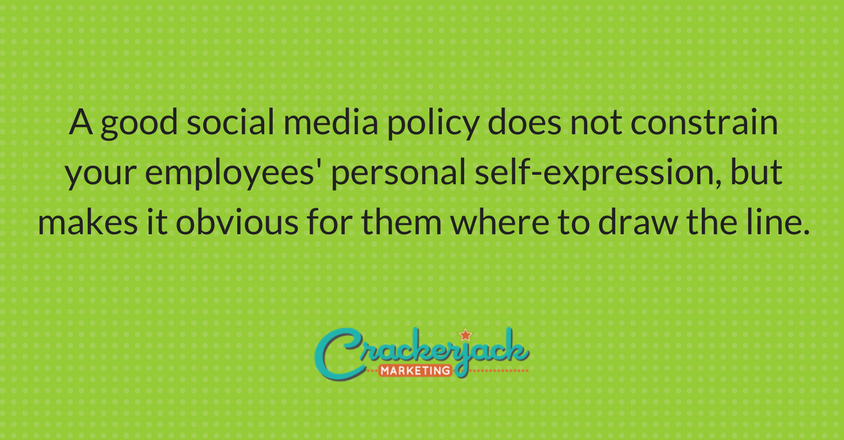Your Corporate Social Media Policy

As a business owner, marketing manager, or executive, you may wonder if your company needs a social media policy. After all, nearly everyone we know uses a Facebook account, and lots of people are Instagramming photos of their families, or posting this weekend’s party on Snapchat. How do you protect your business when your staff are loose on the social web? Smart businesses have social media policies which govern the actions of employees in social media, whether on behalf of the company or while on their own time.
Most social media policies are crafted primarily with company protection in mind. I’d argue that an equally important goal of your policy should be to eliminate confusion on the part of employees, making it safe for them to engage in social media without constantly asking for guidance (or fouling up). Therefore, a good social media policy needs a number of key elements in order to make it easy for employees to follow and clear for HR and executives to interpret. Even if you already have a policy, perhaps it’s worth checking to be sure you’re covering the following eight points.

1. Your Social Media Policy Establishes the Face of Your Company
The first part of your social media policy should cover protecting the company. You’ll want to document who is approved to speak on behalf of the company in social media. This could be anyone, or it could be only those people who have been specifically certified or trained to do so – and possibly only people who have been trained in your brand voice. You will probably want to think of social media in the same way as traditional media; after all, you wouldn’t allow just anyone to do a TV interview on behalf of the company, so why would you allow anyone to tweet for the company? And by “approved to speak,” you might mean in any instance – even the most basic of customer service issues may need to go through your approved social media team.
2. New Social Accounts
Make it clear who is authorized to create social media accounts for the company. Although you have likely already established your Facebook page and other social presences, someone in your organization might have a notion down the road that their branch or product line needs a Twitter account of its own. In order to keep things coordinated, perhaps state that all new social presences require approval and specify where that approval must come from.
3. Employee Personal Content
Set some boundaries for personal content. You probably don’t care whether your staff tweets about their kids or their knitting, so help them to see where the line is between work content and personal content. Some policies suggest that as long as employees are not talking about company-related topics, everything else is fair game.
4. FTC Endorsement Guidelines
Realize that staff do want to talk about their work – after all, they spend a lot of time thinking about work topics and it occupies a large part of their day. But you don’t want your employees to run afoul of the FTC Endorsement Guidelines, pumping up the reputation of your brand without full transparency into their relationship with the company. So include in your policy some info on how to incorporate industry or company information into their own conversations, without running afoul of the FTC rules. This could mean that they have to state their company affiliation in their social profile (but that their opinions are their own), or that they should indicate (#employer, or with an explanation and a link) in their tweets or personal blog posts.
If you’re part of an agency or consultancy that serves multiple clients, the same FTC rules apply, only your employees will need to disclose client posts with #client or an appropriate explanation and link.
5. Employee Advocacy
Do you want your staff to amplify your social messaging – retweeting your content or posting your blog posts to Facebook when it’s appropriate for their audiences? If so, clarify this point and help your team to do so; to streamline this process, you can use employee advocacy tools like Bambu, Circulate.it, or GaggleAMP. But be wary of requiring sharing of staff; it’s really not appropriate to ask people to use their personal profiles for business, and it could reflect badly on your company if it looks like you’re making your staff spam their family and friends with your corporate messaging.
6. What’s Off Limits?
Some content may be totally off-limits for any employee posting anywhere. This probably includes confidential information, posting anything negative about a competitor, or posting anything that could infringe on intellectual property laws, at minimum. While this may all seem obvious, put it in the policy anyway.
7. Customer Service & Employee Feedback
Give employees an outlet for passing along information they see in social media that they feel should be responded to. At the very least, providing an email address to the PR or customer service department within the policy will be a valve release for employees which may prevent them from trying to respond on their own.
8. Be Professional!
Remind everyone about the importance of professionalism and respect for others. This seems to go without saying, but why not put it in writing, just in case? Those videos of the company holiday party with the boss in the lampshade probably won’t be good for your corporate image.
A good social media policy does not constrain your employees’ personal self-expression, but makes it obvious for them where to draw the line. Review some examples of corporate social media policies, work with HR or legal as necessary, and codify something that relieves the stress of “should I or shouldn’t I?” for your staff, while providing you peace of mind.
Have other thoughts about what a social media policy should include? Please share your ideas in the comments.

STEPHANIE SCHWAB
CEO & Founder
Stephanie founder and CEO of Crackerjack Marketing.
She’s been in social media for over 20 years, and teaches digital marketing at universities in Barcelona and Bangkok.
Follow her on LinkedIn
for expert LinkedIn and marketing advice.
Search our Blog
Get our Free Editorial Calendar Template.
Are you stressed out by the time it takes to create great content?
In this handy Google Doc, which you can save and use on your own, you’ll get a super-simple layout to guide your content creation and management efforts.
DOWNLOAD TODAY
Your Corporate Social Media Policy

As a business owner, marketing manager, or executive, you may wonder if your company needs a social media policy. After all, nearly everyone we know uses a Facebook account, and lots of people are Instagramming photos of their families, or posting this weekend’s party on Snapchat. How do you protect your business when your staff are loose on the social web? Smart businesses have social media policies which govern the actions of employees in social media, whether on behalf of the company or while on their own time.
Most social media policies are crafted primarily with company protection in mind. I’d argue that an equally important goal of your policy should be to eliminate confusion on the part of employees, making it safe for them to engage in social media without constantly asking for guidance (or fouling up). Therefore, a good social media policy needs a number of key elements in order to make it easy for employees to follow and clear for HR and executives to interpret. Even if you already have a policy, perhaps it’s worth checking to be sure you’re covering the following eight points.

1. Your Social Media Policy Establishes the Face of Your Company
The first part of your social media policy should cover protecting the company. You’ll want to document who is approved to speak on behalf of the company in social media. This could be anyone, or it could be only those people who have been specifically certified or trained to do so – and possibly only people who have been trained in your brand voice. You will probably want to think of social media in the same way as traditional media; after all, you wouldn’t allow just anyone to do a TV interview on behalf of the company, so why would you allow anyone to tweet for the company? And by “approved to speak,” you might mean in any instance – even the most basic of customer service issues may need to go through your approved social media team.
2. New Social Accounts
Make it clear who is authorized to create social media accounts for the company. Although you have likely already established your Facebook page and other social presences, someone in your organization might have a notion down the road that their branch or product line needs a Twitter account of its own. In order to keep things coordinated, perhaps state that all new social presences require approval and specify where that approval must come from.
3. Employee Personal Content
Set some boundaries for personal content. You probably don’t care whether your staff tweets about their kids or their knitting, so help them to see where the line is between work content and personal content. Some policies suggest that as long as employees are not talking about company-related topics, everything else is fair game.
4. FTC Endorsement Guidelines
Realize that staff do want to talk about their work – after all, they spend a lot of time thinking about work topics and it occupies a large part of their day. But you don’t want your employees to run afoul of the FTC Endorsement Guidelines, pumping up the reputation of your brand without full transparency into their relationship with the company. So include in your policy some info on how to incorporate industry or company information into their own conversations, without running afoul of the FTC rules. This could mean that they have to state their company affiliation in their social profile (but that their opinions are their own), or that they should indicate (#employer, or with an explanation and a link) in their tweets or personal blog posts.
If you’re part of an agency or consultancy that serves multiple clients, the same FTC rules apply, only your employees will need to disclose client posts with #client or an appropriate explanation and link.
5. Employee Advocacy
Do you want your staff to amplify your social messaging – retweeting your content or posting your blog posts to Facebook when it’s appropriate for their audiences? If so, clarify this point and help your team to do so; to streamline this process, you can use employee advocacy tools like Bambu, Circulate.it, or GaggleAMP. But be wary of requiring sharing of staff; it’s really not appropriate to ask people to use their personal profiles for business, and it could reflect badly on your company if it looks like you’re making your staff spam their family and friends with your corporate messaging.
6. What’s Off Limits?
Some content may be totally off-limits for any employee posting anywhere. This probably includes confidential information, posting anything negative about a competitor, or posting anything that could infringe on intellectual property laws, at minimum. While this may all seem obvious, put it in the policy anyway.
7. Customer Service & Employee Feedback
Give employees an outlet for passing along information they see in social media that they feel should be responded to. At the very least, providing an email address to the PR or customer service department within the policy will be a valve release for employees which may prevent them from trying to respond on their own.
8. Be Professional!
Remind everyone about the importance of professionalism and respect for others. This seems to go without saying, but why not put it in writing, just in case? Those videos of the company holiday party with the boss in the lampshade probably won’t be good for your corporate image.
A good social media policy does not constrain your employees’ personal self-expression, but makes it obvious for them where to draw the line. Review some examples of corporate social media policies, work with HR or legal as necessary, and codify something that relieves the stress of “should I or shouldn’t I?” for your staff, while providing you peace of mind.
Have other thoughts about what a social media policy should include? Please share your ideas in the comments.

Search our Blog
Get our Free Editorial Calendar Template.
Are you stressed out by the time it takes to create great content?
In this handy Google Doc, which you can save and use on your own, you’ll get a super-simple layout to guide your content creation and management efforts.
DOWNLOAD TODAY

Your Corporate Social Media Policy

Your Corporate Social Media Policy
STEPHANIE SCHWAB
CEO & Founder
Stephanie founder and CEO of Crackerjack Marketing.
She’s been in social media for over 20 years, and teaches digital marketing at universities in Barcelona and Bangkok.
Follow her on LinkedIn
for expert LinkedIn and marketing advice.
Create your own spark
Join 5,000+ marketers who receive our B2B marketing ideas and insights each week.
Join 5,000+ marketers who receive our B2B marketing ideas and insights each week.
Who we serve
Company
Who we are
Our Services
Blog
Free Editorial Calendar Template
Work With Us
Resources
Chicago, Barcelona, Mumbai
1055 W. Bryn Mawr Suite F-196
Chicago, IL 60660
+1-312-429-5588
Headquarters:
Message us
© Copyright 2024 Kyle Partners, LLC, d/b/a Crackerjack Marketing. All rights reserved. | Terms of Service | Privacy Policy